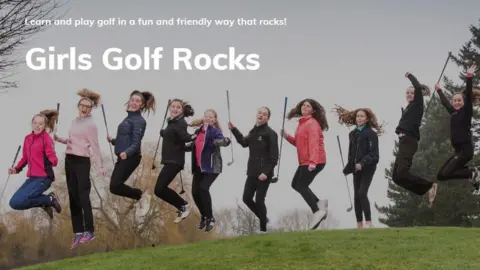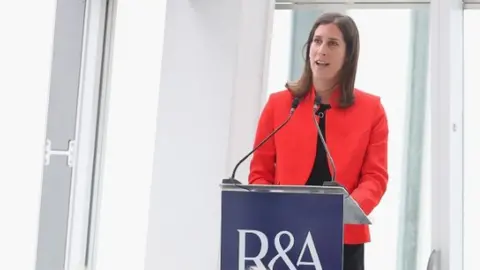Females to the fore? What golf is doing to attract more women
 Getty Images
Getty ImagesGolf has endured a roller coaster decade, with the number of challenges it has faced being matched only by regular bulletins predicting its demise.
The sport has been accused - among other criticisms - of being too white, male, elderly, expensive, time-consuming, and generally out of step in an increasingly inclusive world.
Over the past 12 months, for every fillip provided by a high-profile event such as Tiger Wood's amazing win in the US Masters, it seems there has been bad news about the closure of another golf club.
Faced with a similar situation many businesses would look to expand their appeal, and experts are agreed that the biggest growth potential for golf is enticing more women into the sport.
 Getty Images
Getty ImagesOver the past few years not only have a number of big clubs - such as the Royal and Ancient Golf Club of St Andrews, Muirfield, Royal Troon, Royal Aberdeen, and Royal St George's - dropped their men-only membership stance, but there is now also a positive drive to attract females to the sport.
"A number of clubs in the UK have tried to change and attract more women," says Alistair Dunsmuir, editor of magazine The Golf Business.
"They have introduced women-only golf courses, and coaching sessions, and have looked to attract more female coaching staff. They have also tried to create a more sociable environment, where women can stay behind for a glass of wine afterwards.
 England Golf
England Golf "Other clubs have introduced creches, so that mothers can have a relaxing round of golf or meet with friends in the clubhouse."
He adds: "Golf is also looking to increase its appeal to children and teenagers - the sport has realised if it wants to have growth it can't rely just on older white men."
Meanwhile, participation programmes such as Girls Golf Rocks and Love.Golf, are looking to encourage women to give the sport a try.
Greenkeepers and architects
These initiatives are all positive signs of progress, and indeed at a professional level, there are six women's regional golf tours across the globe, including in the US, Japan. and Europe.
But in terms of general participation, for example across the UK and Ireland, less than 20% of golfers are women. In Sweden that figure rises to 29%, but globally only a quarter of active golfers are female.
And off the playing courses and in the boardrooms at senior executive level, as well as in other industry roles, progress is slow.
 Getty Images
Getty ImagesAccording to research from grass management firm Syngenta, which has been part of the golf industry for more than 30 years, just a fifth of all members of the Golf Club Managers Association - a primarily UK body, but also with some international members - are female.
Their research shows less than 1% of members of Bigga (British & International Golf Greenkeepers Association), are women.
And currently only two women are members of the European Institute of Golf Course Architects (EIGCA).
 EIGCA
EIGCAHowever, the organisation is looking to change this state of affairs, signing up to the RA&'s Women in Golf Charter, and appointing EIGCA member Kari Haug as the architecture organisation's equality advisor.
"I am... so glad that our organisation has committed to play an important role to improve the climate for women in the game, and in the golf industry. I think we are on the cusp of positive and historic cultural change in golf," Ms Haug said.
'Grass roots'
But plugging into a "significant latent demand among non-golfing women", could provide as much as an $35bn (£28bn) a year value to the golf industry, Syngenta suggests.
They also said there could be as many as 37 million prospective new female players around the world interested in taking up the game.
Meanwhile, more female club managers, greenkeepers and golf course architects would drive greater profitability in the golf industry, according to a leading expert on diversity and inclusion in business.
 Getty Images
Getty ImagesLiz Dimmock, founder and boss of Women Ahead, a social impact organisation committed to female development from schoolroom to boardroom, says businesses and sports with more diverse management teams are more profitable.
Yet in the US for example, the world's largest golf market, women make up less than 9% of club general managers, only 1.5% of greenkeepers and there have only ever been a handful of female members of the American Society of Golf Course Architects.
"If you are looking to change the landscape of the sport, then there should undoubtedly be more women in golf - whether it be through increased grass roots players or having more females in leadership positions in the sector, " she says.
 Getty Images
Getty Images"But you need more diverse minds, from a number of different backgrounds, not just based on gender. You need people from outside the sport sector too. And it is not just about representative numbers either, their views need to be treasured and included in the decision-making process."
Ms Dimmock, who has worked for IMG, KPMG, and HSBC, adds: "If golf can do this then there can be huge rewards around the financial side, with more female participation, and more sponsorship opportunities for golf.
"Also when women play or watch sport they often do so as part of a family, bringing more young girls and boys potentially into the sport."
'Inclusive'
The R&A is the body that organises The Open, golf's oldest major championship, and whose 148th tournament is takes place at Royal Portrush in Northern Ireland this week.
It also recently launched a Women in Golf Charter, as part of its drive to increase the number of women and girls playing golf and working within the golf industry.
 Getty Images
Getty ImagesThe charter aims "to inspire an industry-wide commitment to developing a more inclusive culture within golf around the world and to enable more women and girls to flourish and maximise their potential at all levels of the sport".
It will require national federations and other golf bodies to focus on encouraging more women and girls to play golf and stay within the sport as members of clubs, while also empowering women to enjoy successful careers working within the golf industry.
'Important step'
The R&A has provided an initial three-year funding package of £375,000 to its affiliates in Australia, England, Ireland, Scotland and Wales to support the appointment of new development managers to work on increasing participation by women and girls.
 Getty Images
Getty ImagesIt has also increased its prize money by 40% for the 2019 AIG Women's British Open taking place at Woburn next month, to $4.5m (£3.6m), "in recognition of the importance of the Championship and women's golf".
The Women's British Open now offers the second highest prize fund of the five major championships in the women's game.
R&A boss Martin Slumbers says: "This is an important first step and we know it will take time to move closer to achieving parity with the men's game."
